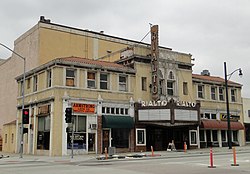
El Capitan Theatre is a fully restored movie palace at 6838 Hollywood Boulevard in the Hollywood neighborhood in Los Angeles, California, United States. The theater and adjacent Hollywood Masonic Temple are owned by The Walt Disney Company and serve as the venue for a majority of the Walt Disney Studios' film premieres.
Landmark Theatres is a movie theatre chain founded in 1974 in the United States. It was formerly dedicated to exhibiting and marketing independent and foreign films. Landmark consists of 34 theatres with 176 screens in 24 markets. It is known for both its historic and newer, more modern theatres. Helmed by its President, Kevin Holloway, Landmark Theatres is part of Cohen Media Group.
The Paseo is an outdoor mall in Pasadena, California, covering three city blocks with office space, shops, restaurants, a movie theater, and 400 loft-style condominiums above.

The Pellissier Building and adjoining Wiltern Theatre is a 12-story, 155-foot (47 m) Art Deco landmark at the corner of Wilshire Boulevard and Western Avenue in Los Angeles, California. The entire complex is commonly referred to as the Wiltern Center. Clad in a blue-green glazed architectural terra-cotta tile and situated diagonal to the street corner, the complex is considered one of the finest examples of Art Deco architecture in the United States. The Wiltern building is owned privately, and the Wiltern Theatre is operated by Live Nation's Los Angeles division.

The Alex Theatre is a landmark located at 216 North Brand Boulevard in Glendale, California, United States. It is currently owned by the city of Glendale and operated by SAS. The theater's capacity is 1,400.
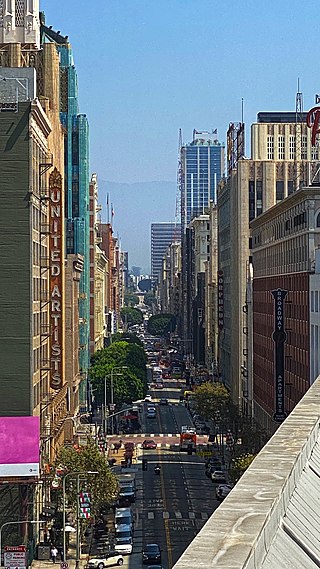
Broadway, until 1890 Fort Street, is a major thoroughfare in Los Angeles County, California, United States. The portion of Broadway from 3rd to 9th streets, in the Historic Core of Downtown Los Angeles, was the city's main commercial street from the 1910s until World War II, and is the location of the Broadway Theater and Commercial District, the first and largest historic theater district listed on the National Register of Historic Places (NRHP). With twelve movie palaces located along a six-block stretch, it is the only large concentration of movie palaces left in the United States.
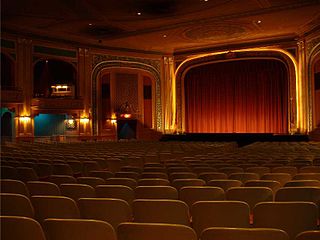
The Lafayette Theatre is a nationally acclaimed movie palace located in downtown Suffern, New York, built in 1923. Its primary function is first-run movies, but it also houses special events like its popular weekly Big Screen Classics film shows. It is also notable for housing a Wurlitzer theatre organ, which is played before Big Screen Classics shows.

The Million Dollar Theatre at 307 S. Broadway in Downtown Los Angeles is one of the first movie palaces built in the United States. It opened in 1917 with the premiere of William S. Hart's The Silent Man. It's the northernmost of the collection of historical movie palaces in the Broadway Theater District and stands directly across from the landmark Bradbury Building. The theater is listed in the National Register of Historic Places.

Fox Theatre is a historic movie theater located on Harbor Boulevard in Fullerton, California. Built in 1925 as part of the chain of Fox Theatres, the theater was closed and abandoned in 1987. The Fullerton Historic Theatre Foundation is currently in the process of fundraising and restoring the theater.

The Hollywood Pantages Theatre, formerly known as RKO Pantages Theatre and Fox-Pantages Theatre, also known as The Pantages, is a live theater and former movie theater located at 6233 Hollywood Boulevard, near Hollywood and Vine, in the Hollywood neighborhood of Los Angeles, California. Designed by architect B. Marcus Priteca, the theater was the last built by the vaudeville impresario Alexander Pantages and also the last movie palace built in Hollywood.
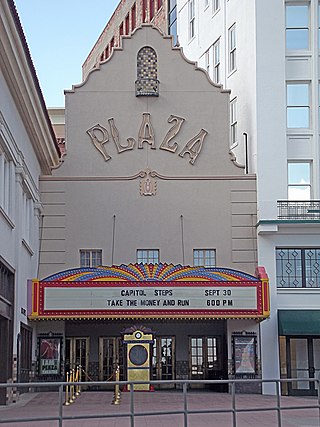
The Plaza Theatre is a historic building in El Paso, Texas, United States, built in 1930. The theater stands as one of the city's most well-known landmarks, and remains operational today. The theatre is a National Historic Building of Significance featuring the 2,050-seat Kendall Kidd Performance Hall, and the smaller 200-seat Philanthropy Theatre. It hosts Broadway productions, musical concerts, individual performers and the annual Plaza Classic Film Festival.

Gaylord Carter was an American organist and the composer of many film scores that were added to silent movies released on video tape or disks. He died from Parkinson's disease.
Fillmore Towne Theatre is a former vaudeville and movie theater in Fillmore, California and is a landmark in downtown. Built in 1916, the single-screen theater showed silent films.
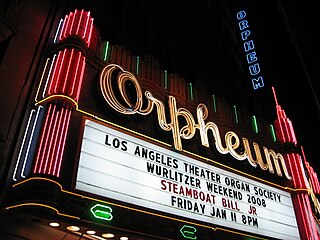
The Orpheum Theatre at 842 S. Broadway in Downtown Los Angeles opened on February 15, 1926, as the fourth and final Los Angeles venue for the Orpheum vaudeville circuit. After a $3 million renovation, started in 1989, it is the most restored of the historical movie palaces in the city. Three previous theatres also bore the name Orpheum before the one at 842 Broadway was the final one with that moniker.

The Broadway Theater District in the Historic Core of Downtown Los Angeles is the first and largest historic theater district listed on the National Register of Historic Places (NRHP). With twelve movie palaces located along a six-block stretch of Broadway, it is the only large concentration of movie palaces left in the United States. The same six-block stretch of Broadway, and an adjacent section of Seventh Street, was also the city's retail hub for the first half of the twentieth century, lined with large and small department stores and specialty stores.

The Majestic Theatre is a performing arts theater in the City Center District of Downtown Dallas. It is the last remnant of Theater Row, the city's historic entertainment center on Elm Street, and is a contributing property in the Harwood Street Historic District. The structure is a Dallas Landmark and is listed on the National Register of Historic Places.

Palace Theatre, formerly Orpheum Theatre, Orpheum-Palace Theatre, Broadway Palace, Fox Palace, and New Palace Theatre, is a historic five-story theater and office building located at 636 S. Broadway in the Broadway Theater District in the historic core of downtown Los Angeles. It is the oldest theater that remains on Broadway and the oldest remaining original Orpheum theater in the United States.
Izek Shomof is an Israeli-born, American real estate developer, investor, one-time film producer and former restaurateur. Born in Tel Aviv, he dropped out of high school to open restaurants and an autoshop. Since the 1990s, he has restored many historic buildings in Downtown Los Angeles. He has been honored for his philanthropic work in reducing homelessness in Los Angeles.

The State Theatre, formerly Loew's State Theatre, at 703 S. Broadway, is a movie theatre that opened in November 1921 in what is now the Jewelry District and Broadway Theatre District in the historic core of Downtown Los Angeles.
